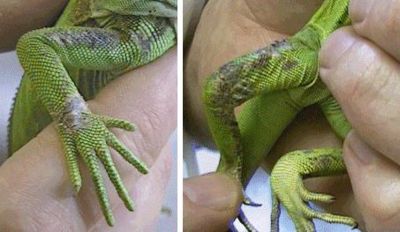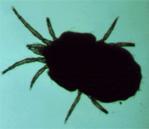Difference between revisions of "Lizard Mites"
| (13 intermediate revisions by 4 users not shown) | |||
| Line 1: | Line 1: | ||
| − | {{ | + | {{OpenPagesTop}} |
| + | ==Introduction== | ||
| + | [[Image:Lizard_mites.jpg|400px|thumb|right|'''Signs of a mite infestation''' (Copyright © RVC)]] | ||
| + | [[Image:Lizard_mite.jpg|200px|thumb|right|'''Lizard mite (''Hirstiella trombidiiformis'') visible on magnification''' (Copyright © RVC)]] | ||
| + | Ectoparasites are a common problem in captive lizards. Mite infestation may result in a pigmented 'black' dermatitis commonly known as "black skin disease", but ticks are rare. As the mites are usually quite ubiquitous, [[Snake Mites|snake mites]] can infest lizards and vice versa. | ||
| − | + | ''Hirstiella trombidiiformis'' is the common lizard mite, and it can be differentiated from another common mite, ''Ophionyssus natricis'' by the presence of a pointed protruberance at the caudal end of its abdomen. | |
| − | == | + | ==Clinical Signs and Diagnosis== |
| − | |||
| − | |||
| − | + | The ectoparasites can usually be found in the axillae and stifle skinfolds of lizards. The tissue damage created by the mite causes swelling, irritation, erythema and even secondary bacterial infection; the skin appears as raised areas of colour change on the skin, generally on the ventral abdomen and limbs. In more serious cases, mite infestation can lead to [[Lizard Dysecdysis|dysecdysis]], anaemia and transmission of bacterial and viral agents (e.g. ''[[Aeromonas species|Aeromonas hydrophila]]'' septicaemia, haemoparasites and [[Inclusion Body Disease|inclusion body disease]]). | |
| − | |||
| − | The ectoparasites can usually be found in the axillae and stifle skinfolds of lizards. The tissue damage created by the mite causes swelling, irritation, erythema and even secondary bacterial infection; the skin appears as raised areas of colour change on the skin, generally on the ventral abdomen and limbs. In more serious cases, mite infestation can lead to dysecdysis and transmission of bacterial and viral agents (e.g. ''Aeromonas hydrophila'' septicaemia, haemoparasites and inclusion body disease). | ||
Individual mites are visible on magnification. They can be seen moving on the host, sometimes in small numbers. They can also be found drowned in the affected animal's water dishes. | Individual mites are visible on magnification. They can be seen moving on the host, sometimes in small numbers. They can also be found drowned in the affected animal's water dishes. | ||
| − | + | ==Treatment== | |
The animal and its environment need to be treated as a big part of the parasite's life cycle is spent off the host. | The animal and its environment need to be treated as a big part of the parasite's life cycle is spent off the host. | ||
| − | * Initially, a bath in warm water will rid the animal of some of the mites. | + | * Initially, a bath in warm water will rid the animal of some of the mites. Alternatively, a cotton bud sprayed with an insecticide (licensed for use in puppies and kittens) can be used to remove groups of mites. |
| − | * Oral or subcutaneous ivermectin | + | * Oral or subcutaneous ivermectin repeated in 2 weeks can be given; the environment should also be sprayed with ivermectin diluted in water. |
| − | * Topical insecticides (e.g. Frontline) | + | * Topical insecticides (e.g. Frontline) can be applied using a sponge. |
| + | |||
| + | ==Prevention== | ||
| + | |||
| + | Preventive medicine including [[Lizard and Snake Quarantine|quarantine]] and appropriate [[Lizard Husbandry Requirements|husbandry]]. | ||
| + | |||
| + | {{Learning | ||
| + | |flashcards = [[Reptiles and Amphibians Q&A 21]] | ||
| + | |full text = [http://www.cabi.org/cabdirect/FullTextPDF/2010/20103181765.pdf '''Reptile ectoparasites - how to kill those little buggers.''' Greek, T.; The North American Veterinary Conference, Gainesville, USA, Small animal and exotics. Proceedings of the North American Veterinary Conference, Orlando, Florida, USA, 16-20 January 2010, 2010, pp 1676-1677 - '''Full Text Article'''] | ||
| + | |||
| + | [http://www.cabi.org/cabdirect/FullTextPDF/2009/20093118403.pdf ''' Reptile parasitology: what is that and how do I treat that?''' Wright, K.; The North American Veterinary Conference, Gainesville, USA, Small animal and exotics. Proceedings of the North American Veterinary Conference, Orlando, Florida, USA, 17-21 January, 2009, 2009, pp 1817-1821 - '''Full Text Article'''] | ||
| + | }} | ||
| + | |||
| + | ==References== | ||
| + | Frye, FL & Williams, DL (1995) '''Self-Assessment Colour Review - Reptiles & Amphibians''' ''Manson'' | ||
| + | |||
| + | |||
| + | {{review}} | ||
| − | + | {{OpenPages}} | |
| − | + | [[Category:Lizard Skin Diseases|M]] | |
| + | [[Category:Expert Review - Exotics]] | ||
Latest revision as of 18:17, 26 July 2012
Introduction
Ectoparasites are a common problem in captive lizards. Mite infestation may result in a pigmented 'black' dermatitis commonly known as "black skin disease", but ticks are rare. As the mites are usually quite ubiquitous, snake mites can infest lizards and vice versa.
Hirstiella trombidiiformis is the common lizard mite, and it can be differentiated from another common mite, Ophionyssus natricis by the presence of a pointed protruberance at the caudal end of its abdomen.
Clinical Signs and Diagnosis
The ectoparasites can usually be found in the axillae and stifle skinfolds of lizards. The tissue damage created by the mite causes swelling, irritation, erythema and even secondary bacterial infection; the skin appears as raised areas of colour change on the skin, generally on the ventral abdomen and limbs. In more serious cases, mite infestation can lead to dysecdysis, anaemia and transmission of bacterial and viral agents (e.g. Aeromonas hydrophila septicaemia, haemoparasites and inclusion body disease).
Individual mites are visible on magnification. They can be seen moving on the host, sometimes in small numbers. They can also be found drowned in the affected animal's water dishes.
Treatment
The animal and its environment need to be treated as a big part of the parasite's life cycle is spent off the host.
- Initially, a bath in warm water will rid the animal of some of the mites. Alternatively, a cotton bud sprayed with an insecticide (licensed for use in puppies and kittens) can be used to remove groups of mites.
- Oral or subcutaneous ivermectin repeated in 2 weeks can be given; the environment should also be sprayed with ivermectin diluted in water.
- Topical insecticides (e.g. Frontline) can be applied using a sponge.
Prevention
Preventive medicine including quarantine and appropriate husbandry.
| Lizard Mites Learning Resources | |
|---|---|
 Test your knowledge using flashcard type questions |
Reptiles and Amphibians Q&A 21 |
 Full text articles available from CAB Abstract (CABI log in required) |
Reptile ectoparasites - how to kill those little buggers. Greek, T.; The North American Veterinary Conference, Gainesville, USA, Small animal and exotics. Proceedings of the North American Veterinary Conference, Orlando, Florida, USA, 16-20 January 2010, 2010, pp 1676-1677 - Full Text Article |
References
Frye, FL & Williams, DL (1995) Self-Assessment Colour Review - Reptiles & Amphibians Manson
| This article has been peer reviewed but is awaiting expert review. If you would like to help with this, please see more information about expert reviewing. |
Error in widget FBRecommend: unable to write file /var/www/wikivet.net/extensions/Widgets/compiled_templates/wrt694c40c18595a2_60291183 Error in widget google+: unable to write file /var/www/wikivet.net/extensions/Widgets/compiled_templates/wrt694c40c18c5237_25613759 Error in widget TwitterTweet: unable to write file /var/www/wikivet.net/extensions/Widgets/compiled_templates/wrt694c40c19110f5_42210245
|
| WikiVet® Introduction - Help WikiVet - Report a Problem |

